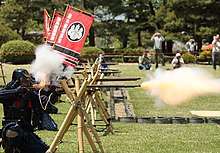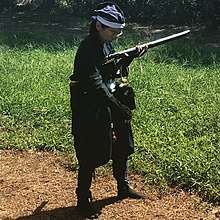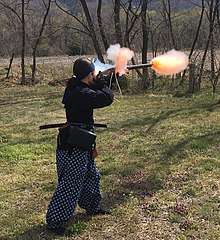Hōjutsu
Hōjutsu (砲術), the art of gunnery, is the martial art of Japan dedicated to firearms usage.

Hōjutsu is still practiced today, often with antique matchlock firearms such as the tanegashima (gun). The martial art is most common in Japan where access to historical equipment is easier for practitioners. Groups such as the Matsumoto Castle Gun Corps maintain large collections of Edo era firearms.
Schools
- Inatomi-ryū
- Geki-ryū
- Ogino-ryū
- Tanegashima-ryū
- Tatsuke-ryū
- Seki-ryū
- Bue-ryū
- Morishige-ryū
- Yō-ryū
- Takashima-ryū

Gun Groups
Gun groups were known as Teppo tai. Teppo (鉄砲) meaning gun and tai meaning group, or unit.
Recently the general media, has come to view the samurai as warriors who were armed only with close combat weapons such as the katana. However, the Japanese were arguably using guns more effectively than their European counterparts by the sixteenth century, as well as producing more accurate, durable varieties. The Battle of Nagashino, where guns tore through charging samurai cavalry, is one of the most famous and influential battles in the history of the samurai.
Ashigaru

The ashigaru were the lowest rank of soldier in feudal Japan, were formed as militia units during times of conflict. The arrival of guns in Japan in 1543 greatly increased the capability of the ashigaru units on the battlefield. Prior to the introduction of firearms, these men would often have to wield polearms and spears like yari or learn to fight with swords and bows. The tanegashima (gun) by comparison was easier to use. It did not rely on physical strength or regular practice to be effective. In addition the firearms could be stockpiled in great numbers when not required. As such, samurai would train the lower classes in hōjutsu.